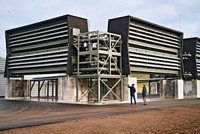Advertisement
Grab your lab coat. Let's get started
Welcome!
Welcome!
Create an account below to get 6 C&EN articles per month, receive newsletters and more - all free.
It seems this is your first time logging in online. Please enter the following information to continue.
As an ACS member you automatically get access to this site. All we need is few more details to create your reading experience.
Not you? Sign in with a different account.
Not you? Sign in with a different account.
ERROR 1
ERROR 1
ERROR 2
ERROR 2
ERROR 2
ERROR 2
ERROR 2
Password and Confirm password must match.
If you have an ACS member number, please enter it here so we can link this account to your membership. (optional)
ERROR 2
ACS values your privacy. By submitting your information, you are gaining access to C&EN and subscribing to our weekly newsletter. We use the information you provide to make your reading experience better, and we will never sell your data to third party members.
Greenhouse Gases
Editorial: Should we capture carbon dioxide from the air?
by C&EN staff
June 3, 2024
| A version of this story appeared in
Volume 102, Issue 17

Answering this question requires some context.
Extracting carbon dioxide from the air, a concept called direct air capture (DAC), is no longer an unusual idea but an emerging sector poised for rapid commercial growth. In Iceland this May, the Swiss company Climeworks started up the world’s first industrial-scale DAC plant. It has been designed to suck 36,000 metric tons (t) of CO2 from the air each year (see our story on page 24).
Many people—including the founders of Climeworks—are convinced that DAC will be an essential lever in preventing runaway climate change. To be effective, the technology needs to scale up so that it is extracting about 10 Gt of CO2 annually from the atmosphere by 2050, Climeworks’ co-CEO Jan Wurzbacher says. That increase would require another 277,778 plants operating at the scale of the one in Iceland.
Climeworks uses amine compounds in open containers to adsorb CO2 from the air. When the amines are saturated with CO2, the containers are closed, and the amines are heated to release the CO2, which is then injected into water and pumped underground. There, it reacts with Iceland’s basalt rock to form a solid carbonate material.
Because CO2 is present in air at a concentration of only 0.04%, Climeworks consumes huge amounts of renewable energy to run fans that pull as much CO2 as possible across the surface of the amines. Additional energy is required to separate the CO2 from the sorbent and then pump the CO2 underground. According to Climeworks’ co-CEO Christoph Gebald, by 2030 the global DAC industry will be consuming up to 25 GW of renewable energy annually—equivalent to about 3% of the world’s total.
Also DAC is expensive. Building the Climeworks plant cost more than $100 million. Each metric ton of CO2 the facility captures and stores costs about $600. By 2050, assuming capture and storage costs will have halved, capturing 10 Gt of CO2 would cost $3 trillion per year.
Researchers are developing a variety of DAC technologies. But it is difficult to imagine that any cheap alternatives to the Climeworks plant will emerge at scale anytime soon.
In a letter to C&EN published in the Feb. 12/19 issue, William A. Levinson asks why not plant trees instead of adopting DAC? His argument is that trees can store CO2at a fraction of the cost while providing additional ecosystem benefits. He has a point.
In our Climeworks story, Mark Z. Jacobson, a professor of civil and environmental engineering at Stanford University, makes the case that DAC will in fact lead to more CO2 in the atmosphere. Jacobson calculates that a more effective way of reducing CO2 in the atmosphere would be to invest the money directly into renewable energy. By his estimation, for every 1 kg of CO2 that Climeworks captures, renewable energy’s displacement of fossil fuel combustion could prevent 3–7 kg from entering the atmosphere.
Other cleantech experts reckon that in certain applications, CO2 from DAC could create value and reduce global CO2 emissions. An example is mineralizing DAC-sourced CO2 in CO2-consuming cement.
The problem is we no longer have the luxury of being able to choose one mitigation measure or another. As Wurzbacher says, to stop runaway climate change, we now need to plant trees and identify a scalable technical solution such as DAC.
The answer then is yes, we should deploy DAC at scale, but only if the CO2 is used in applications—perhaps CO2-consuming cement—in which DAC provides a clear financial value and net benefit to the carbon cycle. We are going to need to use the CO2 captured by DAC more effectively than simply storing it underground or even—as Occidental Petroleum is proposing—using it to push more oil and gas out of depleted wells.
We believe there are a range of options worth exploring for capturing CO2. And most of them point to one certainty: the capacity of innovative chemistry to mitigate the impact of our changing climate.
This editorial is the result of collective deliberation in C&EN. For this week’s editorial, the lead contributor is Alex Scott




Join the conversation
Contact the reporter
Submit a Letter to the Editor for publication
Engage with us on Twitter